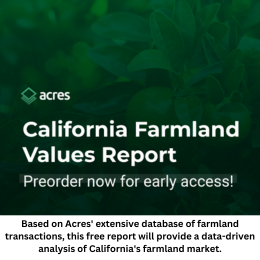July 20, 2015
By Dan Emerson
Recently, California and Iowa-based Homestead Capital announced the final closing of its inaugural farmland investment fund, Homestead Capital USA Farmland Fund I, at $173 million. Homestead Capital USA LLC is a private equity firm focused on investing in operating farmland throughout the Mountain West, Delta, Midwest and Pacific regions of the United States. The fund has already made cornerstone investments of $60 million throughout four key regions across eight projects. To find out more about the fund’s mission and methods, Global Ag Investing spoke with two of the fund’s three partners: Gabe Santos, head of acquisitions and structuring; and Daniel Little, head of portfolio construction.
What was the motivation behind establishing this fund?
Little: Our three partners – Gabe Santos, Gary Thien and myself – are passionate about agriculture and have been wanting to be involved in this space for the long term. Each of us has had a relationship with agriculture. I’m from Ohio, I have a farm there, and, as a career fund manager at J.P. Morgan, I grew an appreciation for the attributes that farmland has as an asset class. Gary has spent his career in agriculture, managing farms and consulting on projects globally. Gabe was involved in Goldman Sachs’ natural resources and agriculture group, where he did mergers and acquisitions in the ag space.
We’re all excited about this investment opportunity. In addition to the compelling investment profile, there are high barriers to entry in agriculture; it’s not an extremely competitive space, relative to traditional real estate and LBO markets. In addition, we think there is a great opportunity to buy farms that are not operating at their full productive capacity, and improve those farms through various value-add strategies, and drive value that way.
What sets your fund apart from other farmland funds?
Santos: It comes down to three core differentiators. One is the team we have. We are one of the few funds that is effectively able to bridge the “farm gate” perspective with portfolio construction, risk management, finance and acquisition structuring. Also, our value-added strategy: we take a hands-on, active management approach to each of our investments, so we can increase productivity, profitability and operational efficiencies on the farms we acquire. Another differentiator is the local presence we have.
How did you choose the geographic regions?
Little: We think the Midwest, the Mountain West, the Pacific and the Delta represent the most compelling opportunities in U.S. agriculture over the next 10 to 15 years. They also present us with great climate and crop diversification. Wherever we were going to own and operate land we had to have boots on the ground. We have identified a team of regional farm managers in all areas where we have strong footholds and networks.
How involved will the fund be in the companies/farms it invests in?
Santos: We are actively involved throughout the entire process: everything from farmer selection, seed selection, crop rotation, capital improvement, monitoring the farm during the growing period, to helping market the crop.
What types of sustainable practices are you focusing on?
Santos: The ones we employ are varied, depending on the type of farm we’re investing in. For example, water efficiency; we can deploy capital to make irrigation systems more efficient. More precise allocation of water can enable us to change crop rotation to a more profitable crop. Other sustainable practices we can use include variable rate of application of fertilizer, no-till farming and the use of cover crops.
When you introduce sustainable practices, how long does it typically take to see the impact on farmland yields?
Little: It varies, but some of them have immediate impact. Switching from a wheel-line system to a pivot irrigation system can reduce water usage 25 percent as soon as you have that in place. On the other hand, wetland mitigation (for example) is a longer process.
What factors go into your risk profiles?
Little: We have an extensive risk-factor model we use in analyzing farmland investments. There are a number of factors. Similar to other asset classes, there is exposure to a number of different risks. There are factors related to weather; water supply, and whether there is a related, legal component. Also, drainage, since excess rain can be as problematic as not enough water. And, the need to be diversified across crops so we are not tied to any particular crop-price movement. This year we are growing nine different crops. We also look at input costs.

Let GAI News inform your engagement in the agriculture sector.
GAI News provides crucial and timely news and insight to help you stay ahead of critical agricultural trends through free delivery of two weekly newsletters, Ag Investing Weekly and AgTech Intel.



